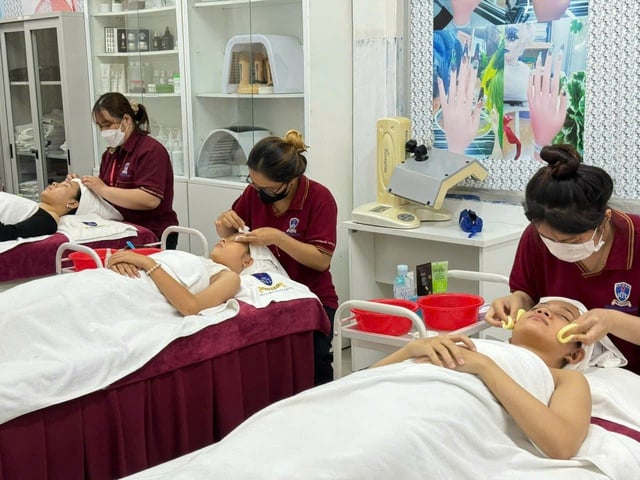For the 2025-2026 school year, the Ho Chi Minh City Department of Education and Training announced that approximately 88,210 students will graduate from junior high school. The enrollment quota for 10th grade in public high schools is 70,070 students (accounting for 79%).
This means that approximately 17,244 remaining students (19.5%) will choose to attend private high schools, vocational training centers, continuing education centers, vocational schools, etc., within the city.
Reduce economic pressure
In recent years, vocational training after graduating from junior high school has gradually become a trend that many students and parents are interested in. A prime example is Xuan Phuc, a student at Le Quy Don Junior High School (District 3), who, despite being only in 7th grade, has participated in many career counseling programs. Phuc is interested in training programs at vocational schools and colleges, and in "hot" fields of study that are expected to become trends in the future.
According to experts, instead of continuing on a purely academic path in high school, choosing vocational training offers novelty and high applicability. Students gain access to practical knowledge and skills in a specific profession from an early age, helping them to better visualize their future career path.

Students who have graduated from junior high school are studying nursing at Nguyen Tat Thanh Vocational School.
According to observations, at Cu Chi Vocational College (Cu Chi District), majors such as automotive technology, refrigeration and air conditioning engineering, and industrial electricity are attracting significant student interest. At Ho Chi Minh City International College (Binh Tan District), majors such as beauty care, industrial electricity, programming, and automotive technology in the 9+ training program are also receiving special attention.
A major advantage of vocational training is the short training duration. Vocational training programs typically last about 2-3 years. Students study both general education and vocational skills. After graduation, they can immediately enter the labor market. Importantly, students can also continue their studies at the college or university level.
According to Mr. Tran Minh Phung, Principal of Cu Chi Vocational College, a highlight of the school's enrollment policy is the complete exemption of tuition fees for students studying at the vocational college level, including vocational training costs and the prescribed general education program.
Ms. Phung explained: "Thanks to tuition fee subsidies from the local government, students who choose to study at the school do not have to pay any tuition fees. This policy is expected to help reduce the financial burden on families, especially those parents whose children do not intend to or are not admitted to public high schools."
Speaking about career guidance for students, Dr. Hoang Quoc Long, Principal of Nguyen Tat Thanh Vocational School (Go Vap District), said that at this age, students are usually more suited to professions that offer direction, spark interest, and provide a foundation for future development, rather than choosing a highly specialized career.
Therefore, the school often encourages male students to choose technical fields such as electrical engineering, refrigeration, and information technology (network assembly, computer repair). For female students, the school's strong fields remain beauty care, culinary arts, and hotel and restaurant management.
"These fields not only have high recruitment demand but also provide favorable conditions for students to transfer or continue their studies at higher levels if they have a clear direction for the future," Dr. Long emphasized.
You shouldn't skip classes.
In the context of increasingly fierce competition for admission to 10th grade in high school, choosing vocational training after 9th grade requires careful consideration based on each student's abilities, interests, and future aspirations. Education experts and representatives from vocational schools advise students and parents to take a long-term view and choose a learning path that suits their capabilities.
Dr. Hoang Quoc Long shared: "Although after graduating from vocational school, students can absolutely apply to universities, we do not encourage them to pursue this path."
Dr. Long explained that vocational education and higher education are relatively different. Vocational education focuses on practical skills training, while higher education specializes in research and theory. This difference can easily overwhelm students graduating from vocational schools when they enter a university environment.
"We still encourage students to pursue further education at the college level to gain more work experience before continuing their studies at a higher level. Taking it step by step, from vocational school to college and then university, will help them be better prepared in terms of both knowledge and practical skills," Dr. Long explained.
This view is also shared by Mr. Nguyen Dang Ly, Principal of Ho Chi Minh City International College. Mr. Ly believes that vocational training in stages, "slow but steady," will help students build a solid foundation of knowledge and skills, and accumulate practical experience before continuing to conquer academic heights. "Accelerating" or trying to enter unsuitable environments can create unnecessary pressure and not yield long-term results.
"Therefore, for the 9+ training program, students will study 8 subjects according to the 2018 general education curriculum (an increase of 1 subject compared to the previous 7 subjects). The school prioritizes providing systematic training in cultural subjects for students in the initial stage before they become familiar with their chosen profession," - Ms. Ly informed.
Currently, vocational schools and colleges in Ho Chi Minh City are striving to develop high-quality training programs that are closely linked to the actual needs of the labor market, while also creating favorable conditions for students to continue their education at higher levels.
Facing difficulties
Increasing enrollment quotas for 10th grade in public high schools for the 2025-2026 school year is a "tough game" for vocational schools. The principal of Cu Chi Vocational College stated that the school has completed counseling sessions at 24 junior high schools in Cu Chi district, setting an enrollment target of 450 students this year across 9 training programs.
According to the principal of Ho Chi Minh City International College, the school has received approximately 40 applications for admission so far, a significant increase compared to last year. However, the school remains cautious in setting its enrollment targets. For the 2025-2026 academic year, the school plans to enroll 300 students across 10 majors (a decrease of 50 students compared to the previous year).
Source: https://nld.com.vn/hoc-nghe-sau-lop-9-lua-chon-moi-ung-dung-cao-196250427215500256.htm




![[Photo] Prime Minister Pham Minh Chinh presides over a meeting on private sector economic development.](/_next/image?url=https%3A%2F%2Fvphoto.vietnam.vn%2Fthumb%2F1200x675%2Fvietnam%2Fresource%2FIMAGE%2F2025%2F12%2F20%2F1766237501876_thiet-ke-chua-co-ten-40-png.webp&w=3840&q=75)































































































Comment (0)